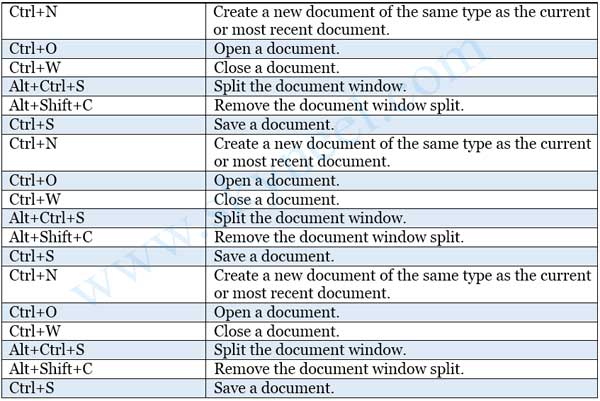Microsoft Word Keyboard Shortcuts
A wiki-style reference database for keyboard shortcuts. 157 Shortcuts for Microsoft Word. Related: Word Index, Microsoft Office Shortcuts, Word. 60 Essential Microsoft Office Keyboard Shortcuts for Word, Excel, and PowerPoint. When you’re typing away in Word, remember these keyboard shortcuts to save time. They’re much more efficient than hunting through layers of menus for an uncommon setting. 69 rows Below is a listing of the more commonly used shortcut keys in Microsoft Word.See the.
By Thanks to the, Word 2016 is a lot easier to use than in the old keyboard days. Still, keyboard shortcuts linger. The function key commands here are listed as they are mapped within. Other programs installed on your computer may hijack certain key combinations. Also, some laptop computers may require you to press the Fn key in combination with the function keys to fully access their features. F1 key shortcuts Unmodified Display the online Help for Word 2016.
You can search for help, browse categories, and be otherwise baffled by the information displayed. Shift Display (or hide) the Reveal Formatting pane. Ctrl Show or hide the Ribbon. Alt Go to the next field. Shift+Ctrl Maximize the document window to fill the screen and hide the Ribbon. Shift+Alt Go to the previous field in the document. Ctrl+Alt Display the System Information window.

F2 key shortcuts Unmodified Move To command. Select text and press F2. Click to position the insertion pointer, and then press the Enter key to cut and paste the selected block. Shift Copy To command.
Select text and press Shift+F2. Move the insertion pointer and press Enter to copy the selected text. Ctrl Summon the Print Preview screen; the same as pressing Ctrl+P. Shift+Alt Save command; same as Ctrl+S. Ctrl+Alt Summon the Open dialog box. F3 key shortcuts Unmodified Insert building block.
Type the first part of the building block text, and then press F3. Shift Change Case command.

Press Shift+F3 to cycle between lowercase, uppercase, and Sentence Case formats. Ctrl Cut selected text and store it in the Spike. The Spike can contain a collection of cut items, similar to the Clipboard; however, spiked items are not stored in the Clipboard. Alt Create a new Building Block entry. After you press Alt+F3, the Create New Building Block dialog box appears.
Shift+Ctrl Paste the contents of the spike. All spiked items (cut with Ctrl+F3) are inserted into the document. This is not the same command as Ctrl+V. F4 key shortcuts Unmodified Repeat command; the same as Ctrl+Y or Redo. Shift Repeat last browse object, such as Repeat Last Find or repeat the last Go To command, such as Go to Page. Ctrl Close the window; the same as the Ctrl+W command. Alt Quit the program.
The Alt+F4 keyboard shortcut is the standard Windows command to close any window or program. Shift+Alt Close the window; the same as Ctrl+W and Ctrl+F4. F5 key shortcuts Unmodified Summon the Go To dialog box, or the Find and Replace dialog box with the Go To tab forward. Shift Move the insertion pointer to the last edit in the document.
This command can be repeated four times to cycle through various locations. Ctrl Restore document window. Alt Restore program window. Shift+Ctrl Display the Bookmark dialog box. F6 key shortcuts Unmodified Cycle to the next open frame or pane.
Shift Cycle to the previous open frame or pane. Ctrl Cycle to the next document window.
Alt Cycle to the next document window; the same as Ctrl+F6. Shift+Ctrl Cycle to the previous document window. Shift+Alt Cycle to the previous document window; the same as Shift+Ctrl+F6. F7 key shortcuts Unmodified Proof the document. Shift Open the Thesaurus pane for the current word.
Alt Move the insertion pointer to the next misspelled word. Shift+Ctrl Update Source command. This command applies to the IncludeText field and directs Word to update the contents based on the source document.
Shift+Alt Open the Translation pane for the current word. Ctrl+Alt Summon the Korean-language spell checker. (A bug?) F8 key shortcuts Unmodified Activate extended selection mode.
Use the cursor keys to extend the selection; type a character to extend the selection; press F8 again to select a larger document chunk. Shift Shrink the extended selection.
Press Shift+F8 to undo the last F8 key press. Ctrl Change the window’s size (though it doesn’t work in Word 2016). Alt Display the Macros dialog box. Shift+Ctrl Enter block selection mode. In this mode, you select a rectangular chunk of text. Use the cursor keys or mouse to highlight a rectangle of text in the document.
You can work with the block selection just as you can with any chunk of selected text. F9 key shortcuts Unmodified Update the current field: Click in a field and press the F9 key. The Ctrl+Shift+U key does the same thing. Ctrl Insert an empty field, a pair of curly brackets with nothing between them. Alt Toggle field codes for all fields in the document.
Shift+Ctrl Convert the current field into plain text. Shift+Alt Simulate a user clicking on a field for programming macros.
Word Keyboard Shortcuts

F10 key shortcuts Unmodified Display Ribbon accelerator-key shortcuts. Shift Nonfunctioning shortcut menu command. Ctrl Maximize the document window. Alt Show or hide the Selection pane. Shift+Ctrl Assigned to the WW2RulerMode command, which no one knows anything about.
Shift+Alt Displays the smart tag menu. F11 key shortcuts Unmodified Go to the next field in the document. Shift Go to the previous field in the document. Ctrl Lock the field. Alt Display the Visual Basic Editor.
Shift+Ctrl Unlock the field. F12 key shortcuts Unmodified Summon the Save As dialog box. This command works whether or not the document has been saved.
Shift Summon the Save As screen if the document hasn’t already been saved. Ctrl Summon the Open dialog box. Shift+Ctrl Summon the Print screen; the same as Ctrl+P. Shift+Alt Activate the button on a selected content control.